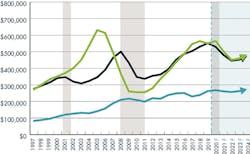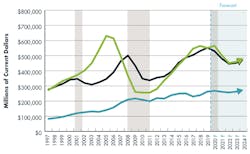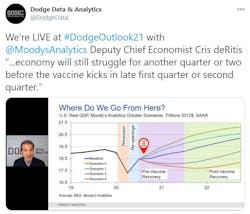Our essential industry’s most trying year mercifully draws to a close this month, but 2020’s profound impact on design, construction, jobsite safety, remote technology use, workplace operations, crisis management, backlog planning, and much more, will be felt for decades to come.
In the short term, though, firms are desperate to read the tea leaves for signs of economic recovery in the weeks and months ahead. In the U.S., as a new Presidential Administration prepares to take office and prospects for a real Coronavirus vaccine now seem viable by spring, causes for optimism are finally growing. Indeed, November even ended with the stock market on a welcome rise.
Still, industry economists are a cautious bunch. And who could blame them after this dark year of unexpected global crises and unfathomable societal challenge? No matter how hopeful any of us might be, we all know the road back will be steeply uphill.
Toward that end, Dodge Data & Analytics last month released its annual Construction Industry Outlook for 2021. The detailed, multi-market report predicted that total U.S. construction starts will increase 4% to $771 billion next year.
“The COVID-19 pandemic and recession has had a profound impact on the U.S. economy, leading to a deep drop-off in construction starts in the first half of 2020,” explained Richard Branch, Dodge Data’s Chief Economist. “While the recovery is underway, the road to full recovery will be long and fraught with potential potholes. After losing an estimated 14% in 2020 to $738 billion, total starts will regain just 4% in 2021.”
Branch added, “Uncertainty surrounding the next wave of COVID-19 infections in the fall and winter and delayed fiscal stimulus will lead to a slow and jagged recovery in 2021. Business and consumer confidence will improve over the year as further stimulus comes in early 2021 and a vaccine is approved and becomes more widely distributed. But construction markets have been deeply scarred and will take considerable time to fully recover.”
Speaking alonsgide Branch at the “Dodge Outlook 2021” online event on Nov. 18, Moody Analytics’ Deputy Chief Economist Cris deRitis echoed that assessment. “The economy will still struggle for another quarter or two before the vaccine kicks in late first quarter or second quarter,” he predicted.
For its part, FMI Corp. takes a longer, five-year view. Making its predictions earlier in the fall, the industry analytics firm says its construction put-in-place data reflects building decisions acted upon in cycles of 18 to 24 months.
“What we’re looking at over the next four years, are really two stories,” said Jay Bowman, FMI’s managing director of research and analytics. “We expect to see two years of decline followed by two of potential rise.”
While noting that the pandemic has derailed the amusement and hospitality markets for several years, he added other markets like offices and schools should bounce back sooner. Healthcare projects, for example, remained stable through this year of health crisis and will likely slow for two years before bouncing back in 2023, according to FMI.
In the near term, Dodge Data believes 2021 will be bouyed by a 5% rise in housing starts, a 3% gain in nonresidential projects, and a 7% surge in infrastructure work. “Only the residential sector, however, will exceed its 2019 level of starts, thanks to historically low mortgage rates that boost single-family housing,” noted Branch. “(Those) rates and a preference for less dense living during the pandemic are clearly overpowering short-term labor market and economic concerns.”
While Dodge expects multifamily construction to struggle next year, especially for apartments in large metro areas, it does foresee commercial building starts climbing 5% in 2021. Warehouse construction will be the clear winner as e-commerce giants like Amazon continue to build out their logistics infrastructure. (For more on such work, see this month’s cover story.)
Institutional construction starts will also increase next year, according to Dodge, albeit by just 1%, as growing state and local budget deficits continue to hold back public building construction. As a result, education projects are expected to see further declines in 2021, while healthcare starts are predicted to rise as hospitals seek to boost in-patient bed counts.
Whenever public funding is available again, K-12 schools will be a priority, predicts Ken Simonson, chief economist for Associated General Contractors of America (AGC). And new, pandemic-related spacing needs will drive much construction.
“At some point, we’ll be sending kids back to school and we have the same number of kids we had before,” Simonson said last month, speaking to Equipment World magazine. “We need additional schools, expansions, and renovation of older school buildings. So, schools look good from a demand standpoint.”
Indeed, funding questions hang like a thick cloud over every business decision now as we enter this weary winter. The extended November election season this fall proved so contentious and bitterly partisan that another round of badly needed economic stimulus checks never materialized. At press time, a new bipartisan effort in Congress to pass relief legislation that would send $900 billion to needy Americans had just been proposed. But its fate was uncertain.
In late October, when industry economist Anirban Basu, chairman of the Sage Policy Group, realized that there would be no renewed stimulus before the Nov. 3 election, he posted this Tweet in obvious frustration:
“Congress thought that the aggressive recovery since May meant that they didn’t need to act. They were wrong. The economy heads toward recession #2 as COVID-19 engulfs phase I of recovery. The V becomes a W. Winter will be bleak, but this too shall pass!!!! #Dickensianwinter!”
Last month, AGC officials also urged Congress to craft a new series of coronavirus relief measures to help offset declining demand for most types of nonresidential construction. Specifically, AGC sought new infrastructure investments, liability reforms “to protect honest firms from unwarranted pandemic lawsuits” and an extension of, and new flexibility for, measures like the Paycheck Protection Program. They also urged Congress to ensure the current administration does not move forward with its plans to tax firms that used PPP loans to protect essential construction jobs.
“With the pandemic raging again in most parts of the country, countless construction jobs are at risk as owners cancel or delay projects amid uncertainty about the future,” said AGC CEO Stephen E. Sandherr. “Enacting new recovery measures now will help protect many good-paying construction careers during what will likely be a difficult winter for the economy.”
Relief in the next few months to come could make all the difference for many design firms, particularly smaller architecture and engineering (A/E) shops. Last month, the U.S. Census Bureau put its “advance estimate” of total A/E firm revenues for the third quarter of 2020 (Q3) at $80.08 billion, an 11.8% decline from the same quarter last year. The estimate is less than a half-point improvement from the $79.77 billion in A/E revenues in Q2, which was the first full quarter of the pandemic-caused recession.
“Frankly it’s probably good news that Q3 didn’t decline further from Q2,” said Erin McLaughlin, VP of private market programs at the American Council of Engineering Companies (ACEC). “Basically since the pandemic started, our industry’s revenues are down about 12 percent.”
Where all of us will be when the Q4 results are tallied is a concern, of course. But despite all the persistent challenges still ahead, it now seems quite possible that each quarter of 2021 will be better than the last.
##########
About the Author
Rob McManamy
Editor in Chief
An industry reporter and editor since 1987, McManamy joined HPAC Engineering in September 2017, after three years with BuiltWorlds.com, a Chicago-based media startup focused on tech innovation in the built environment. He has been covering design and construction issues for more than 30 years, having started at Engineering News-Record (ENR) in New York, before becoming its Midwest Bureau Chief in 1990. In 1998, McManamy was named Editor-in-Chief of Design-Build magazine, where he served for four years. He subsequently worked as an editor and freelance writer for Building Design + Construction and Public Works magazines.
A native of Bronx, NY, he is a graduate of both the University of Virginia, and The John Marshall Law School in Chicago.
Contact him at [email protected].






